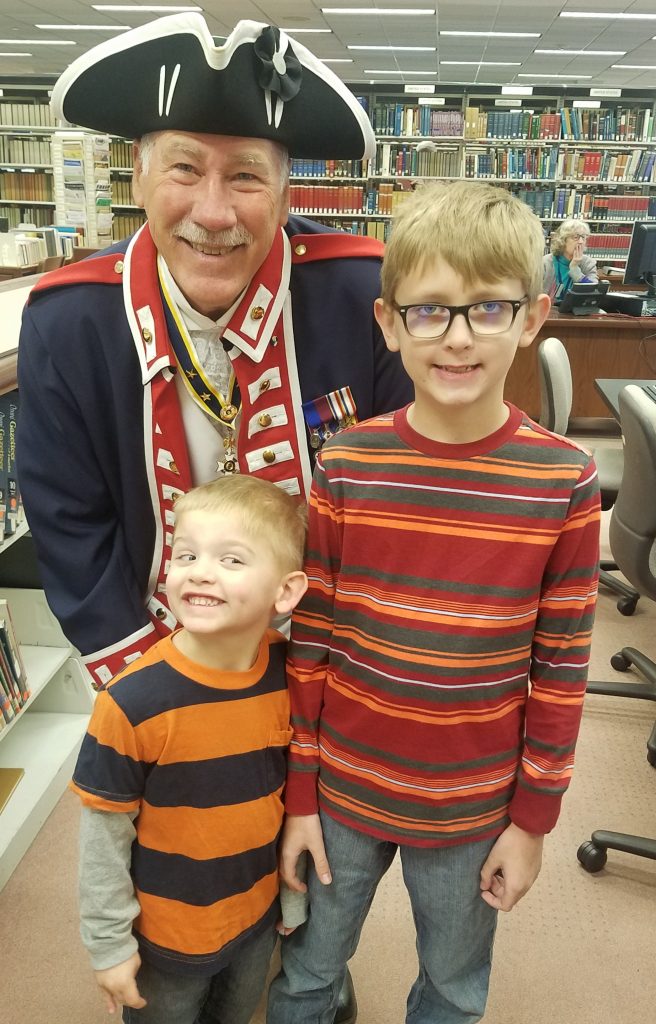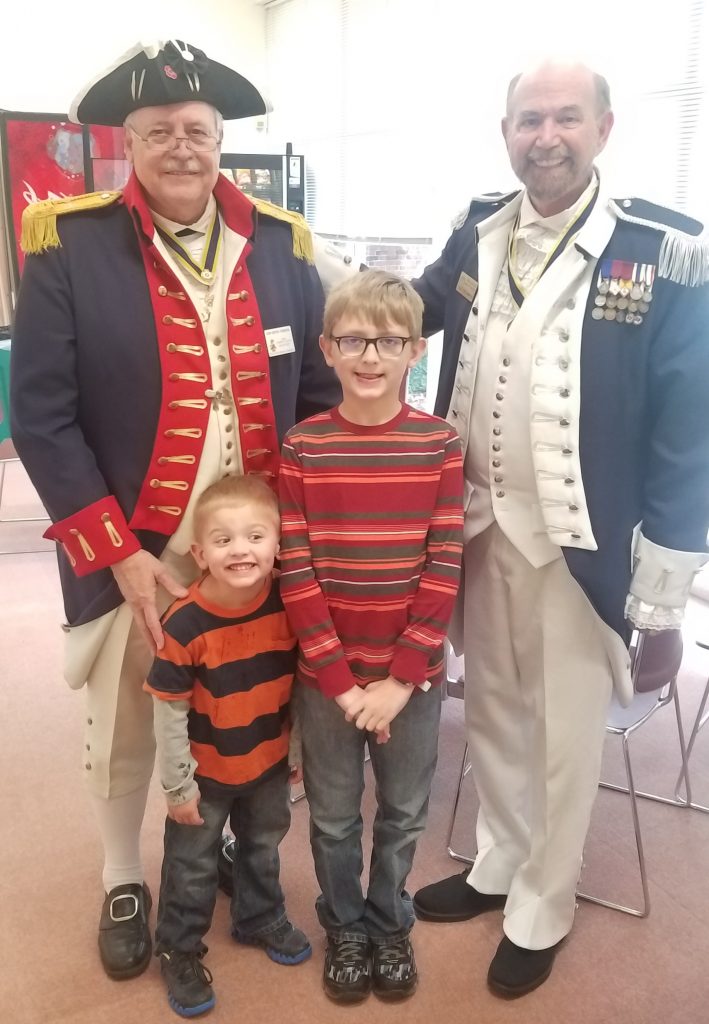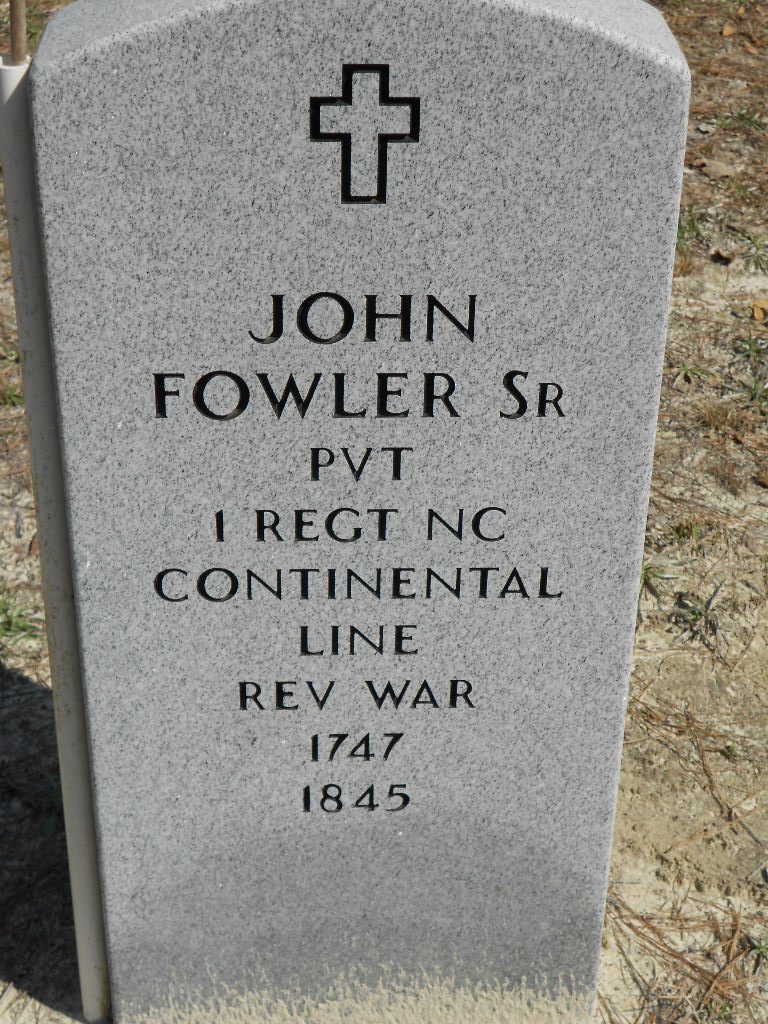This entry is part of the 52 Ancestors in 52 Weeks series. This week’s prompt is AT THE LIBRARY. To see other posts in this series, view my 52 Ancestors in 2019 index.
As both a genealogist and mom of two young boys, I’m always looking for ways to integrate genealogy into our everyday lives. I want my children to have personal connections to history and identify with our ancestors in concrete ways. Clayton Library, my local genealogy center here in Houston, provided an excellent opportunity this past Saturday with DAR (Daughters of the American Revolution) Day. Representatives from Sons of the American Revolution (SAR) also attended and wore replica soldiers’ uniforms — a great photo op for the kids!

Jeffrey and Jonathan Collins with Texas SAR Representatives – Clayton Library, Houston, Texas, 26 Jan 2019 
Jeffrey and Jonathan Collins with Texas SAR Representatives – Clayton Library, Houston, Texas, 26 Jan 2019
SAR members shared how their ancestors’ Revolutionary War service inspire the types of uniforms they wear. One member even told my four year old the story of Paul Revere’s dog retrieving his forgotten spurs before his famous midnight ride. I wish my boys would have listened more intently, but — well, they’re young boys. We’re working on it.
Seeing the uniforms led to a lunchtime discussion about the eight Patriots we have on my side of the family — four who served as soldiers and four who are recognized for civil and patriotic service. John Fowler, my 5x-great-grandfather, is one of these ancestors. Vital records are lacking for this time period, but his detailed pension records tell much about his life.
John Fowler was born in 1747 in Duplin County, North Carolina.¹ He likely married Elizabeth Rackley in 1776.²
John appeared before the Superior Court of Columbus County, North Carolina, on November 12, 1832, to submit testimony of his Revolutionary War service in order to obtain a pension.³ He was 85 years old, and although he couldn’t remember the specific dates he enlisted, John provided details about his three terms of service for the Patriot cause.
John first enlisted as a private for a term of six months and served under Captain Richard Clinton and Colonel James Kenan. He received a bounty of three dollars and a pair of boots. The company marched to Wilmington and was employed to guard the town and form scouting parties against the Tories. John saw action on February 27, 1776, at the Battle of Moores Creek Bridge, a Patriot victory that effectively ended British authority in North Carolina. Less than two months after this battle, North Carolina became the first colony to vote in favor of independence. John was given a discharge after the battle.
John next enlisted at Wilmington as a private in the 1st North Carolina Continental Regiment for a term of twelve months. He served under Captain Alfred Moore. Their regiment marched to Charleston, South Carolina, and returned to Wilmington at the end of his enlistment period.
About a year after his tour in the Continental service, John volunteered a third time as private — this time with a company of militia commanded by Captain William Vann. He agreed to a three-month term, marched to Blueford’s Bridge, and was then stationed at Holly Shelter. While at Holly Shelter, his company was set upon by the British and his captain ordered retreat. They were so closely pursued by the British that John said he was “obliged to throw their ammunition in the river.”⁴ The men were ordered to disperse and return home, and John’s term of service expired by the time he reached home.
Luke R. Simmons and Joseph Nobles testified on behalf of John and agreed that they believed him to be about 85 years old and was regarded in the neighborhood as a Revolutionary War soldier. Charles Hay and Ezekiel Hawes also appeared before the court and testified they served with John in the militia under Captain Vann. John’s pension was granted, and he received $30 per year.
John had to answer several questions during the pension application process, including places he had lived. He stated he was born in Sampson (then Duplin) County, had lived about twenty years in Lancaster District, South Carolina, and presently lived in Columbus County, North Carolina. In a place and age before city directories, what a helpful find in the pension files to track John’s movements!
But just when you think John would be settling down in his old age, he made another move. On December 16, 1840, Luke R. Simmons wrote a letter on John’s behalf to the Commissioner of Pensions in Washington, D.C.⁵ In the letter, Luke explained John had moved to Pike County, Alabama, in the fall of 1837. John was robbed of all his money and his pension certificate during the trip and wanted to know how to obtain a duplicate certificate. The answer must have been to appear before court. A copy of John’s Pike County, Alabama, court appearance is included in his pension file. He testified on October 7, 1843, that he was the same person who formerly had a Revolutionary War pension in Columbus County, North Carolina. He stated he moved to Pike County to “be nearer his children and to do better for his family.”⁶

Gravestone of John Fowler, Sr. (1747-1845), Stephens-Wright Cemetery, Sandy Plain, Columbus County, North Carolina; gravestone photograph by Linda.
The pension file notes a duplicate pension certificate was issued on October 13, 1845; however, it may have been too late for John to receive it. His gravestone lists his year of death as 1845.⁷ Calculated from his self-reported birthdate, John lived to age 98 — a long life lived through a pivotal period of American history. He is buried in Stephens-Wright Cemetery in Sandy Plain, Columbus County, North Carolina.
¹”U.S., Revolutionary War Pension and Bounty-Land Warrant Application Files, 1800-1900,” application no. S16809, John Fowler; database with images, Ancestry.com (https://www.ancestry.com/interactive/1995/MIUSA1775D_135592-00155/21650 : accessed 31 Jan 2019).
²”U.S. and International Marriage Records, 1560-1900,” database, Ancestry.com (https://search.ancestry.com/cgi-bin/sse.dll?indiv=1&dbid=7836&h=428886&ssrc=pt&tid=49495569&pid=112075140843 : accessed 1 Feb 2019), entry for John Fowler – Elizabeth Rackley, 1776.
³”U.S., Revolutionary War Pension and Bounty-Land Warrant Application Files, 1800-1900,” application no. S16809, John Fowler; database with images, Ancestry.com (https://www.ancestry.com/interactive/1995/MIUSA1775D_135592-00155/21650 : accessed 31 Jan 2019).
⁴Ibid.
⁵Ibid.
⁶Ibid.
⁷Ancestry, Find A Grave, database with images (https://www.findagrave.com/memorial/88105417/john-fowler : accessed 31 Jan 2019), memorial 88105417, Pvt. John Fowler, Sr. (1747-1845), Stephens-Wright Cemetery, Sandy Plain, Columbus County, North Carolina; gravestone photograph by Linda.

Jess, where is John Fowler in relation to James Spruel Fowler who m. Mahala Elizabeth Faulk?
John Fowler was my 5th great uncle.
His brother Daniel Fowler Jr was my 5 great grandfather.
Family history says the women soaped or greased the bridge at Moore’s Creek so the loyalist fell into the creek.
Have you ever heard that story?
Awesome! I haven’t heard that story, but now I’m going to Google it. 🙂
It may be just folk lore I don’t really know. But it has been passed down on both sides of my family. Fowler and Barnhill.
I am amazed at the amount of information you can find. I just started seeking my Fowler Family history. John Fowler who was born in 1747 in Taylor’s Bridge, North Carolina was my 5th Great-grandfather. I have joined Ancestry.com and will soon submit my DNA. Hopefully to find more of my ancestors.
Hi, my mother was a Fowler from Columbus County (Ironically, my grandmother’s name was Earlene Fowler). I can trace my direct line to Daniel Fowler, John’s brother.
The story about the greased bridge is true. I am from Wilmington and have been to Moores Creek National Battlefield many times as a child an adult. The park rangers there give a good account of how it all unfolded.
I would love to join the DAR, but am having a hard time providing the multiple documents needed.
Hi Amy. I truly enjoyed reading your message especially since your grandmother was Earlene Fowler from Columbus County.
The state line runs through our family farm. Part is in Columbus City and the other part is in Horry County SC.
I also have a Barnhill from my maternal side ancestor that was at Moore’s Creek also. I’ve often wondered if the two gentlemen knew each other.
I would love to share any information I have with you and vice versa from you.
Earline
Always enjoy your mini histories! This was especially interesting since my Fowlers have been told for years John Fowler and Elizabeth Rackley were our ancestors. I could not find the docs to satisfy myself this was true, so pretty much forgot about it.
Then, Ancestry Thrulines listed John and Elizabeth Fowler as my potential ancestors. I would have discounted this, but I had 83 dna matches for John and 65 for Elizabeth. My sister had even more–88 for John and 74 for Elizabeth. My brother beat us both, with 94 matches for John and 73 for Elizabeth.
Now, I KNOW ThruLine is just a guide but numbers like these are interesting, anyway. I am going to ask a favor from those of you who are satisfied you are descended from John and Elizabeth Fowler. What documents convinced you? Would you share them with me? We have our Fowler line proved through Edward William Fowler (1795 SC to 1848 AL) and Haney Sims (1796 SC to 1880 AL).
Also, We have dna kits at Ancestry.com, FTDNA.com, 23andMe.com, Gedmatch.com, MyHeritage.com and a few other places. My Fowler uncle did a YDNA test at FTDNA as well. Any of you guys tested there? Always happy to share infomation.
This is quite interesting! Thank you for sharing it. I am particularly interested to read that John Fowler moved to Pike County, Alabama to “be nearer his children.” This is exactly what I was looking for. Before reading the witness share this in his testimony, I had speculated that this was the reason he moved to Pike County.
I make a 100% DNA connection to John’s parents, Daniel Fowler and Mary Jane Rollins, and have looked at what is known about the lives of each of their children, including John, to see which child could have been the mother of my John Thomas Cartrette OR the father or mother of John Thomas Cartrette’s unknown first wife, who I come through. John Thomas Cartrette was from Columbus County, NC, born about 1784. He and his unknown wife moved to Pike County in the 1820’s from Columbus Co, NC. They had a number of children born in North Carolina, and then more born in Pike County. John Cartrette’s unknown wife died before 1845. Although the family lore is that his wife was possibly a native american woman, there is no documentation for this.
There is always a possibility that John Thomas Cartrette’s mother was the Fowler, but I have focused in on John Fowler because he also moved from Columbus County, NC to Pike County “to be near his children.” Could he have moved to be near one of his daughters (the wife of John Thomas Cartrette?).
What can you tell me about John’s known children in Pike County?
Thank you so much!